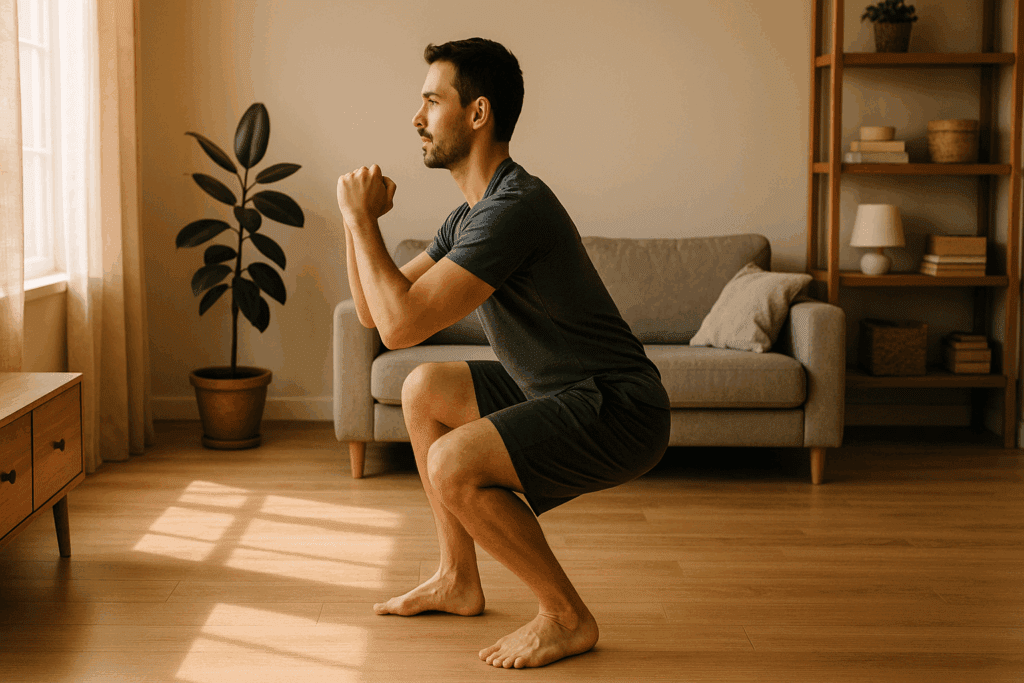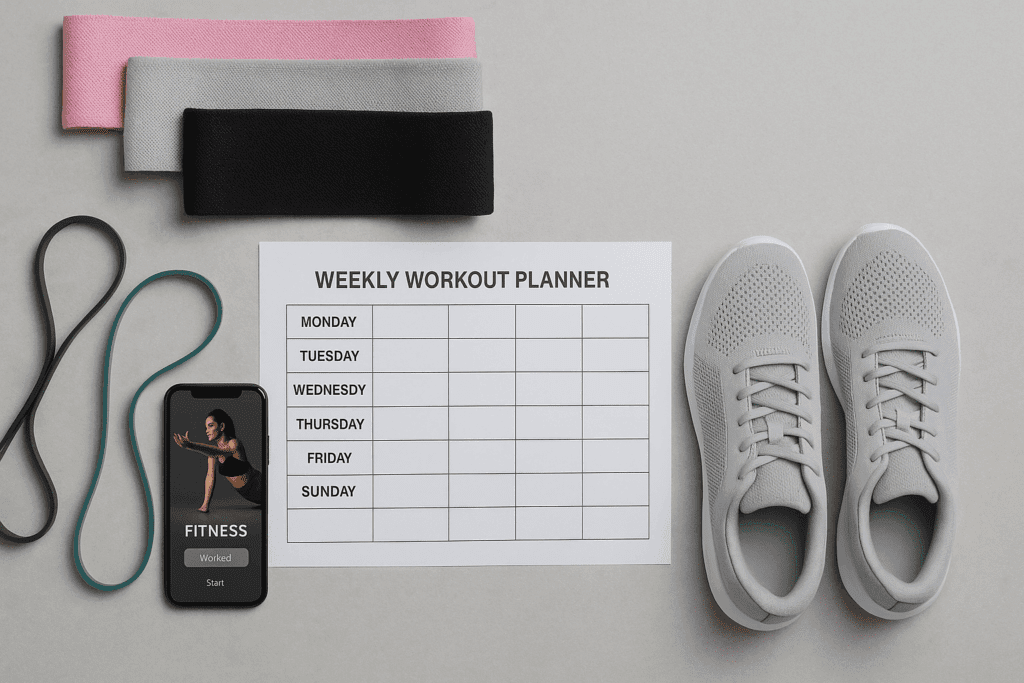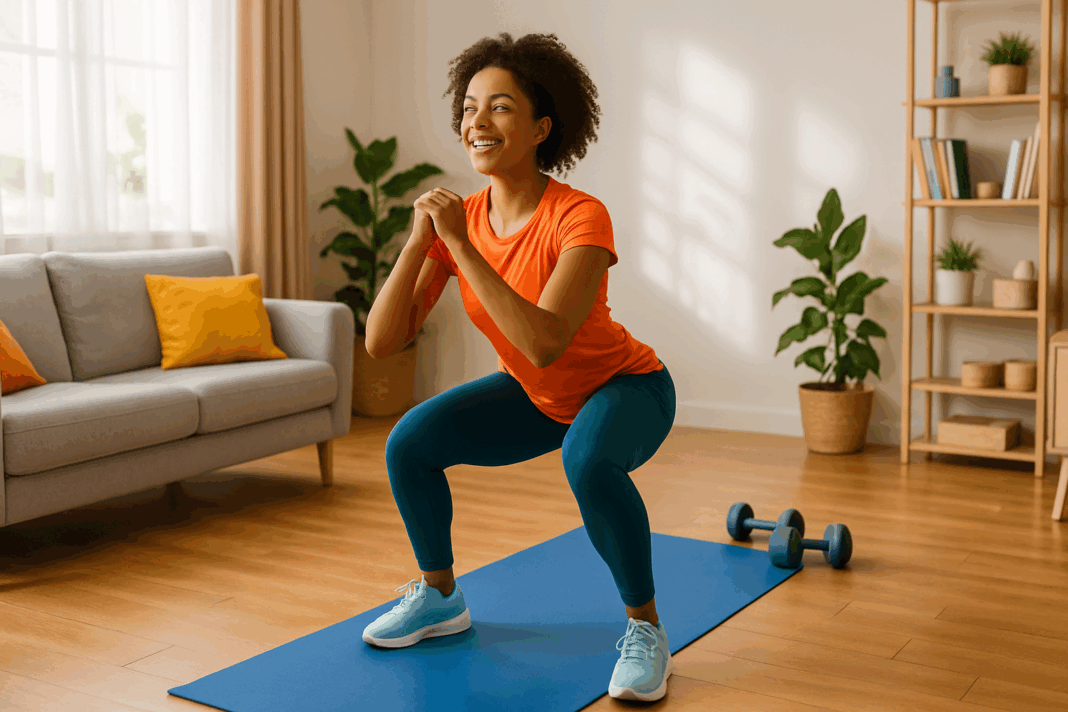Introduction: Why At-Home Fitness Matters in Today’s Busy World
As the pace of modern life accelerates, many people find themselves struggling to maintain physical fitness while juggling work, family, and social responsibilities. Gyms may offer state-of-the-art equipment and classes, but the time, cost, and travel associated with gym memberships can be significant barriers to consistent participation. For beginners seeking sustainable and effective ways to enhance their strength and endurance, establishing a comprehensive at home workout plan offers a practical and empowering solution. Whether you’re returning to fitness after a break or starting fresh, knowing how to get fit at home for beginners can reshape your wellness journey with minimal equipment and maximum flexibility.
You may also like: How to Increase Stamina and Endurance Naturally: Smart Training Tips and Nutrition Habits That Support Cardiovascular Fitness
This article is designed to serve as both a comprehensive guide and motivational resource, combining expert insights with evidence-based strategies to help readers develop a weekly exercise routine at home. From daily workout plans that improve stamina and cardiovascular health to easy workout routines that support gradual strength-building, we explore everything needed to create a personalized fitness plan home setup that is realistic, engaging, and effective. By the end of this piece, readers will have a clearer understanding of how to approach fitness exercises in a structured yet adaptable way that aligns with their lifestyle and fitness goals.

Understanding the Foundations of Functional Fitness
Before diving into the specifics of a weekly training plan, it’s important to understand the underlying principles of functional fitness. This term refers to exercises that mimic real-life movements, enhancing your ability to perform everyday activities with ease, balance, and coordination. For beginners, functional movements serve as a gentle yet effective way to build both muscular and cardiovascular strength without the need for expensive gym equipment. These exercises emphasize natural body movements like squatting, pushing, pulling, and twisting, forming the foundation of most at home workout plans.
Integrating functional fitness into your routine helps improve posture, reduce injury risk, and support long-term mobility—particularly important for individuals who spend much of their day sitting or engaging in repetitive motions. Additionally, these types of fitness exercises often rely on body weight or minimal resistance, making them ideal for those who are just getting started. They not only build foundational strength but also stimulate endurance through dynamic, multi-joint movements. A well-rounded plan will progressively layer these exercises into a broader daily workout plan at home, ensuring balanced development over time.

How to Get Fit at Home for Beginners: Setting Goals That Stick
Embarking on a fitness journey from home requires more than just enthusiasm—it demands clear, realistic goal setting. For beginners, this often means identifying short-term objectives that pave the way for long-term success. Whether your aim is to improve stamina, shed excess weight, build muscle tone, or simply feel more energetic throughout the day, defining your “why” is a crucial step in sustaining motivation. Goals should follow the SMART framework: specific, measurable, achievable, relevant, and time-bound.
For example, instead of vaguely stating “I want to get in shape,” consider framing your goal as “I will follow a daily workout plan at home for 20 minutes, five times a week, for the next month.” This level of specificity not only clarifies your path forward but also provides tangible benchmarks for tracking progress. It is equally essential to pair physical goals with behavioral goals, such as committing to consistent sleep schedules or healthier meal prep routines. Combining these elements fosters a holistic approach to fitness and reinforces the benefits of easy workout routines integrated into everyday life.

Creating a Personalized Fitness Plan at Home
Developing a personalized fitness plan home setup begins with an honest assessment of your current fitness level, time availability, and personal preferences. Are you more energized in the morning or evening? Do you enjoy high-energy cardio or slower, strength-focused routines? Answering these questions will help tailor your plan to fit your natural rhythms and increase the likelihood of long-term adherence. For beginners, a balanced mix of cardiovascular, strength, flexibility, and mobility exercises is key to building foundational fitness.
A sample weekly schedule might include bodyweight strength training on Mondays and Thursdays, cardio workouts such as jumping jacks or step routines on Tuesdays and Fridays, and active recovery practices like yoga or stretching on Wednesdays and Saturdays. Sundays can be designated for complete rest or light walking. This type of structure provides variety and prevents both physical burnout and mental boredom. Your at home workout plan should also remain flexible—adaptations are inevitable, and learning to pivot gracefully is part of building fitness resilience.
The Role of Easy Workout Routines in Building Momentum
One of the most common barriers for beginners is feeling overwhelmed by complex or demanding exercise plans. That’s where easy workout routines play an essential role. These routines offer a gentle entry point into physical activity, promoting consistency without discouragement. Examples include a 10-minute bodyweight circuit of squats, push-ups, and planks, or a low-impact cardio session that incorporates marching in place, arm circles, and side steps. When practiced consistently, these seemingly simple movements can yield substantial improvements in endurance and muscular strength.
Beyond their accessibility, easy workout routines help beginners develop confidence in their physical abilities. Each completed session reinforces a positive feedback loop, making it more likely that fitness will become a habit rather than a chore. Moreover, these routines can be scaled up gradually in intensity or duration as strength and stamina improve, allowing for progression without overexertion. The key is to begin where you are and to move forward with patience and persistence, celebrating every milestone along the way.

Crafting a Sustainable Daily Workout Plan at Home
Creating a daily workout plan at home that is sustainable requires a blend of structure and flexibility. Rather than aiming for perfection, the focus should be on building a routine that aligns with your lifestyle and accommodates the inevitable fluctuations of energy and motivation. Start by designating a specific time each day for your workout, treating it as a non-negotiable appointment with yourself. Consistency in timing reinforces habit formation and reduces decision fatigue.
Each daily session should include a warm-up, a main workout block, and a cool-down period. For instance, a 30-minute session might start with five minutes of dynamic stretching, followed by 20 minutes of strength or cardio training, and ending with five minutes of static stretching or breathwork. The daily structure can vary in intensity—alternating between high and low effort days to avoid overtraining. Incorporating rest or active recovery days into your weekly schedule ensures that the body has adequate time to repair and adapt, which is critical for performance enhancement and injury prevention.

Endurance and Stamina: Training for Long-Term Benefits
Stamina and endurance are foundational components of physical fitness that influence how efficiently the body uses energy during prolonged activity. Training to improve these attributes involves consistent cardiovascular exercise paired with muscular endurance training. Cardiovascular exercises such as brisk walking, jogging in place, or dance routines elevate heart rate, enhance lung capacity, and improve circulation—all of which support stamina. Strength-based endurance exercises like lunges, squats, and resistance band work sustain muscle engagement over time, reinforcing muscular endurance.
The key to boosting endurance through fitness exercises at home lies in progressive overload—gradually increasing the intensity, duration, or frequency of workouts. This might mean adding five more minutes to your cardio session every week or increasing the number of reps in your strength routine. In addition, mixing steady-state cardio with interval training can help improve both aerobic and anaerobic systems. The result is a greater ability to sustain activity, reduced fatigue during daily tasks, and a stronger, more resilient cardiovascular system.
The Importance of Variety in Your Weekly Exercise Routine at Home
One of the greatest advantages of a weekly exercise routine at home is the opportunity to inject variety into your workouts. Incorporating different types of exercises prevents monotony, keeps motivation high, and ensures that different muscle groups are activated throughout the week. A varied routine might alternate between high-energy aerobic sessions, calming yoga flows, strength training circuits, and mobility drills. This not only enhances overall fitness but also reduces the likelihood of overuse injuries and burnout.
Variety also allows you to explore different movement styles and discover what brings you joy. For instance, you might find that dance-inspired cardio energizes you, while bodyweight Pilates offers a grounding, strengthening experience. As your fitness evolves, your preferences may shift—and your plan should evolve accordingly. By listening to your body and remaining open to new forms of movement, your at home workout plan becomes a living, dynamic process that grows with you. This adaptability reinforces the sustainability of the routine and helps cement fitness as a lifelong practice.

Nutrition and Recovery: Supporting Strength and Stamina Gains
No fitness journey is complete without attention to nutrition and recovery, two often-overlooked pillars of physical progress. Proper nutrition fuels workouts and accelerates muscle repair, while rest and recovery allow the body to adapt and grow stronger. For beginners engaged in daily workout plans at home, balanced meals rich in whole foods—including lean proteins, complex carbohydrates, healthy fats, and plenty of vegetables—are essential. Hydration also plays a key role, as even mild dehydration can impair physical performance and concentration.
Equally important is the integration of recovery strategies such as quality sleep, stretching, foam rolling, and relaxation techniques. These practices reduce soreness, improve circulation, and support the nervous system’s ability to rebound from training stress. Beginners may be tempted to overtrain in the enthusiasm of early progress, but honoring the body’s need for rest is a sign of discipline, not weakness. Integrating rest days into your weekly exercise routine at home will not only prevent injury but also ensure long-term adherence by preserving mental and physical energy.
Monitoring Progress and Staying Motivated
Tracking your progress is a powerful way to stay engaged and motivated throughout your fitness journey. This can be done through a variety of methods: keeping a fitness journal, logging workouts in a mobile app, taking periodic photos, or noting improvements in energy, mood, and daily function. Objective metrics like increased reps, longer cardio sessions, or reduced recovery time between exercises also provide tangible evidence of progress. These markers validate your efforts and serve as fuel during moments when motivation wanes.
Additionally, celebrating small wins—such as completing a full week of your fitness plan home or mastering a new movement—reinforces positive behavior and keeps momentum alive. It can also be helpful to involve others in your journey, whether through virtual fitness groups, social media communities, or a workout buddy. Sharing goals and accomplishments builds accountability and reminds you that you’re part of a larger movement of people embracing healthy change. Staying inspired isn’t about perfection; it’s about continuing to show up, one workout at a time.
Frequently Asked Questions: Building Strength and Stamina at Home
1. How can I stay motivated to follow an at home workout plan long-term?
Staying motivated with an at home workout plan often requires building a strong emotional connection to your fitness goals. Many people find it helpful to link exercise with other personal values such as mental health, stress relief, or being active with family. Creating a dedicated space in your home for movement can psychologically cue your brain to enter “fitness mode,” making your sessions feel more intentional. To keep things fresh, rotate through new fitness exercises every few weeks to maintain interest and prevent plateaus. Additionally, tracking progress through photos or fitness journals offers tangible proof of improvement and reinforces your commitment.
2. What role does sleep play in a successful daily workout plan at home?
Sleep is a vital component of any daily workout plan at home, as it supports muscle repair, hormone regulation, and cognitive function. Without quality rest, the body cannot fully recover from the stress of exercise, which can lead to fatigue, poor performance, and even injury over time. Beginners should prioritize a consistent sleep routine just as seriously as their fitness schedule. Getting 7–9 hours of rest each night ensures the body has time to process adaptations and integrate the benefits of your fitness exercises. For those struggling with sleep, consider incorporating calming evening routines like light stretching or breathwork to improve both sleep and workout quality.
3. How do I know when it’s time to increase the intensity of my fitness plan home routine?
Recognizing when to increase intensity in your fitness plan home strategy requires paying attention to both physical signals and performance benchmarks. If you find that you’re completing your usual routine with ease, experiencing less post-workout fatigue, or no longer feeling challenged, it’s a sign your body is ready for progression. You can enhance intensity by adding repetitions, reducing rest time, or including resistance bands and weights. It’s also valuable to alternate higher intensity sessions with recovery-focused days to build stamina while preventing burnout. Always progress gradually and mindfully to avoid overtraining or injury.
4. Can easy workout routines actually lead to meaningful improvements in stamina?
Yes, easy workout routines can lead to significant gains in stamina when practiced consistently and strategically. While they may not feel as intense initially, these workouts allow for the development of baseline cardiovascular endurance, especially when performed regularly over weeks or months. Low-impact sessions that raise your heart rate without overwhelming your system promote blood flow and lung capacity in a sustainable manner. For example, a brisk 20-minute indoor walk with arm movements, when done daily, can noticeably boost stamina. The key is repetition and gradual overload, even with movements that feel manageable.
5. What if I miss several days of my weekly exercise routine at home? Is my progress lost?
Missing a few days of your weekly exercise routine at home does not erase your progress, but it does emphasize the importance of consistency over perfection. Life disruptions happen, and your fitness journey should allow room for flexibility without guilt. One strategy is to plan for “buffer” days in your schedule—time that can be used to make up for missed sessions if needed. If you do skip workouts, simply pick up where you left off rather than starting over completely. Your body retains adaptations like muscle memory and endurance improvements longer than you might think, making it easier to resume your rhythm.
6. Are there social or psychological benefits to following an at home workout plan?
Absolutely—following an at home workout plan can improve more than just physical health. Many people report feeling greater self-confidence, reduced anxiety, and enhanced emotional regulation after incorporating regular movement into their day. Additionally, virtual workout communities or sharing your journey with friends can add a layer of social accountability and support, which enhances motivation. Engaging in daily fitness exercises can also create a positive ripple effect, encouraging healthier choices in other areas of life such as nutrition and stress management. Over time, this fosters a greater sense of self-efficacy and overall well-being.
7. What equipment is most useful for a beginner-friendly fitness plan home setup?
While you can achieve great results with just bodyweight exercises, adding a few key items can enhance variety and progression in your fitness plan home environment. Resistance bands, light dumbbells, a yoga mat, and a stability ball are excellent investments that don’t require much space. These tools allow you to increase difficulty gradually while improving range of motion and muscle activation. For those interested in cardiovascular conditioning, a jump rope or a set of aerobic steps can bring added intensity. Importantly, choose equipment that aligns with your interests and goals, so it complements your easy workout routines rather than complicates them.
8. How do I tailor my daily workout plan at home if I have joint pain or mobility limitations?
Individuals with joint pain or limited mobility can still benefit from a structured daily workout plan at home by focusing on modifications that reduce impact and promote joint stability. Chair-based exercises, wall-assisted movements, and aquatic workouts (if accessible) are excellent low-impact options that protect the joints while still building strength. Strengthening the muscles around the affected joints through controlled resistance training can also alleviate discomfort over time. It’s important to prioritize form over intensity and consult with a physical therapist if pain persists. With thoughtful adjustments, even modified fitness exercises can support functional movement and overall health.
9. Can a weekly exercise routine at home support long-term weight management?
Yes, a consistent weekly exercise routine at home plays a crucial role in weight management, especially when paired with mindful nutrition. While exercise alone is not a magic solution, it significantly boosts metabolic function, preserves lean muscle mass, and regulates appetite-related hormones. Cardio sessions increase calorie expenditure, while strength training enhances your resting metabolic rate, making your body more efficient at burning calories even at rest. The key to sustainable weight management is regularity—performing fitness exercises multiple times per week rather than relying on sporadic effort. Integrating exercise into your lifestyle makes it a powerful tool for both prevention and progress.
10. How do I measure progress beyond just physical appearance when following an at home workout plan?
Measuring progress goes far beyond the mirror. Many people following an at home workout plan experience enhanced mood, better focus, improved sleep, and increased energy levels before any major visual changes occur. Fitness trackers or apps can log improvements in strength, speed, endurance, or workout duration. Another useful measure is functional capacity—how much easier daily tasks feel as your body becomes more efficient. Journaling your journey, including how you feel mentally and emotionally, can provide a rich, motivating record of how much you’ve grown. These non-scale victories often reflect the true power of a well-structured fitness plan home experience.
Conclusion: Embracing the Long-Term Power of Easy Workout Routines at Home
Building strength and stamina through at-home fitness isn’t just about looking better or hitting short-term goals—it’s about cultivating a lifestyle rooted in vitality, resilience, and self-care. With the right blend of structure and flexibility, even beginners can craft an easy workout routine that evolves into a deeply rewarding habit. Whether you’re starting with a few minutes of movement each day or committing to a full weekly exercise routine at home, what matters most is consistency, intentionality, and the willingness to grow.
By integrating principles of functional fitness, structured planning, varied training methods, and attentive recovery practices, your at home workout plan becomes more than a series of isolated exercises—it becomes a foundation for physical and mental transformation. With every rep, step, and stretch, you reinforce your commitment to health and empowerment. This journey, grounded in personalized fitness exercises and mindful daily habits, offers a sustainable path to performance enhancement and enduring stamina. And it all begins right where you are: at home.
Was this article helpful? Don’t let it stop with you. Share it right now with someone who needs to see it—whether it’s a friend, a colleague, or your whole network. And if staying ahead on this topic matters to you, subscribe to this publication for the most up-to-date information. You’ll get the latest insights delivered straight to you—no searching, no missing out.

